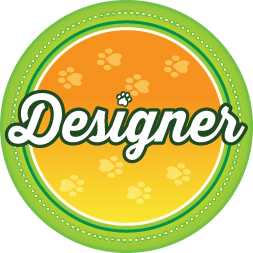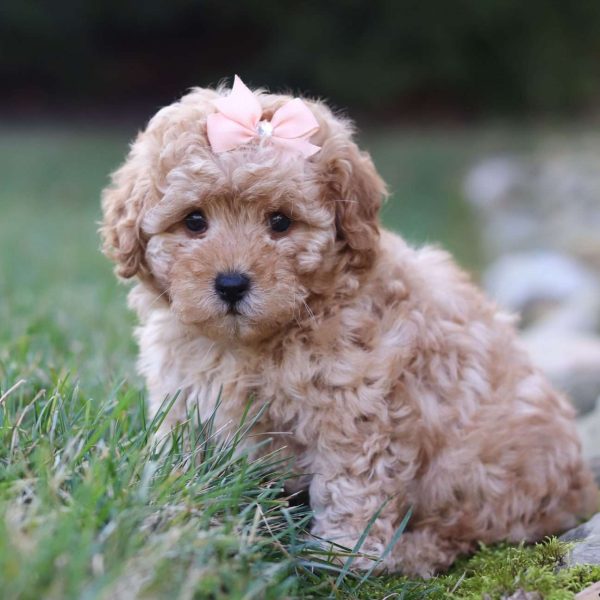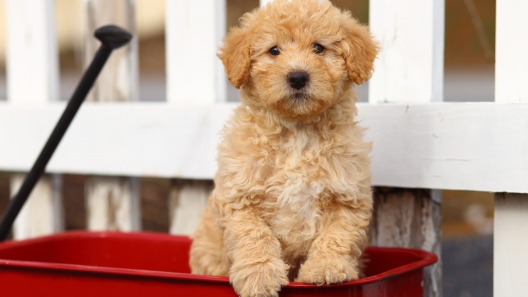
-
Activity Level:
moderate
-
Shedding Level:
low
-
Grooming Level:
high
-
Trainability:
high
-
Good for Novice Owners:
high
-
Adaptability:
high
-
Kid/Pet Friendly:
often
-
Prey Drive:
high
-
Watchdog:
very alert
- Average Size: Medium
- Average Lifespan: 10-15 years
- Registered?: other
Schnoodle Dog Breed Information
Overview
Temperament
Adaptability
Health
Owner Experience
Grooming
Activity Level
Size
Life Span
Did You Know?
The Schnoodle is a designer dog breed that was developed in the 1980s in the United States. They are a cross between a Schnauzer and a Poodle. There is a Mini Schnoodle, but this Schnoodle is a cross between a Standard Poodle and a Standard or Giant Schnauzer. As a mixed dog breed, the Schnoodle can take on any combination of traits from one or both of the parent breeds.
Overall, Schnoodles tend to be intelligent and loving dogs with playful personalities that are also devoted to their families. In addition to being a beloved family pet, the Schnoodle can also be found working as a therapy dog. This dog breed may not be recognized by the American Kennel Club, but they are recognized by other professional dog organizations like the American Canine Hybrid Club, Designer Dogs Kennel Club, and more.
Schnoodles are cute and adorable dogs no matter their size. They also tend to be an ideal family pet as they get along with children, other pets, and other dogs. Their playful personality and friendly disposition make them a great addition to a family.
The Schnoodle is also loyal and affectionate to their families. Because they are so friendly, they also tend to be quite excitable and may be prone to jumping up on people in their excitement. Structure, training, and socialization early on can help curb this behavior.
The Schnoodle is a highly adaptable dog breed. They do well in both apartments as well as in larger homes. As long as they get enough exercise, mental stimulation, and affection, they tend to be quite happy wherever they are.
They do well in most climates. As with any dog breed, they are sensitive to heat. They also tend to bond closely with their families and enjoy being near you, so they do not like to be left alone for long periods of time.
A mixed dog breed can inherit the potential health concerns common to one, both, or neither of the parent breeds. When it comes to the Schnoodle, potential health concerns to be aware of include cataracts, progressive retinal atrophy, patellar luxation, diabetes, Addison’s disease, bloat, epilepsy, Addison’s Disease, and Legg-Calve-Perthes Disease.
Responsible breeders will screen their stock to make sure they are preventing genetic disorders from passing on to puppies. So, don’t be afraid to ask the breeder about the genetic history of the parents. You can also ask about any relevant health clearances or test results.
The Schnoodle is a product of two highly intelligent dog breeds that are eager to please their owners. They tend to pick up on things quickly and will learn fast. This makes them highly trainable dogs that are a good fit for owners of all experience levels. But, Schnoodles also get bored easily, so training needs to be kept interesting to keep them engaged.
If a Schnoodle is motivated and challenged during training and using positive methods focused on praise and reward, they tend to master the basics quickly. Then, they’re often ready to move on to more advanced commands. Enrolling in puppy training classes is always an option no matter your experience level. Plus, these classes tend to offer great opportunities to socialize a puppy.
Although the Schnoodle can inherit the low-shedding, hypoallergenic coat of the Poodle, there is no guarantee that they will. They will likely be low-shedding as the Schnauzer does not generally shed much. But, low-shedding does not mean low-maintenance. So, you need to be prepared for a coat that is any combination of a Poodle and a Schnauzer.
If your Schnoodle has more of a Poodle coat, you will need to brush them daily to remove tangles and prevent mats. You will also need to get professional grooming done about every 4-6 weeks. Should your Schnoodle inherit more of a Schnauzer coat, they still will not shed much, but will need weekly brushing. Plus, their coat will need to be bathed, stripped, and clipped regularly to stay healthy, which usually means professional grooming every 5-8 weeks.
In addition to coat care, you will also need to care for your Schnoodle’s nails, ears, and teeth. Some of this can be handled during professional grooming sessions, but you’ll need to do some maintenance in between sessions at home. Monthly nail trimming is usually sufficient to keep nails from growing too long. But, you may need to cut your dog’s nails more often if they grow quickly or are not wearing down as much naturally. Checking your dog’s ears weekly and carefully cleaning them as needed can help prevent ear infections.
Proper dental for dogs is also important. Gum disease is one of the most common health issues in dogs because good dental care is often overlooked. But, your dog’s teeth need regular care just as yours do to stay healthy. Brushing your dog’s teeth or using an enzyme toothpaste every day is ideal for helping to prevent painful dental diseases later in life. You can also talk to your vet about dental hygiene chews and treats or even a specially-formulated “dental care diet”.
A Schnoodle tends to have a moderate activity level. Daily walks plus some playtime or extra activity is usually plenty for this dog. But, they will also follow your lead and love to spend time with you. So, they’re usually up for more activity if you are.
Try out different activities to see which ones your Schnoodle likes the most. Take trips to the dog park, go on hikes, try out swimming, go for a run or jog, play frisbee, and more. Although they can’t compete in “official” events, you can also train your Schnoodle in dog sports like flyball, agility, and more. They’ll likely enjoy being active and learning something new.
A fully-grown Schnoodle usually stands 16-28 inches tall at the shoulder and weighs between 30-95 pounds. If one of the parent breeds is a Standard Schnauzer, your Schnoodle will likely be towards the lower to the middle portion of this range. If one of the parent breeds is a Giant Schnauzer, your Schnoodle will likely be towards the middle to the upper portion of this range.
A Schnoodle generally lives 10-15 years.
Although Schnoodle is the most common name for this designer dog breed, they are also sometimes referred to as a Schnauzerdoodle or Schnauzerpoo.









